Light is more powerful than it appears. Beyond enabling vision and setting our biological rhythms, light, when delivered in specific wavelengths, can influence the very foundation of our health: our cells. This is the basis of Photobiomodulation (PBM), a form of light-based medical intervention.
It’s a revolutionary, non-invasive treatment that’s gaining traction in the medical and wellness communities for its ability to support healing, reduce inflammation, and fight disease at the cellular level. Let’s explore how this cutting-edge therapy rewires your body from the inside out.
Key takeaway: Light therapy, or photobiomodulation (PBM), uses specific wavelengths of light to penetrate cells, boosting mitochondrial function and ATP production. This enhances cellular repair, reduces inflammation, and strengthens the body’s ability to fight disease.
What is Photobiomodulation (PBM)?
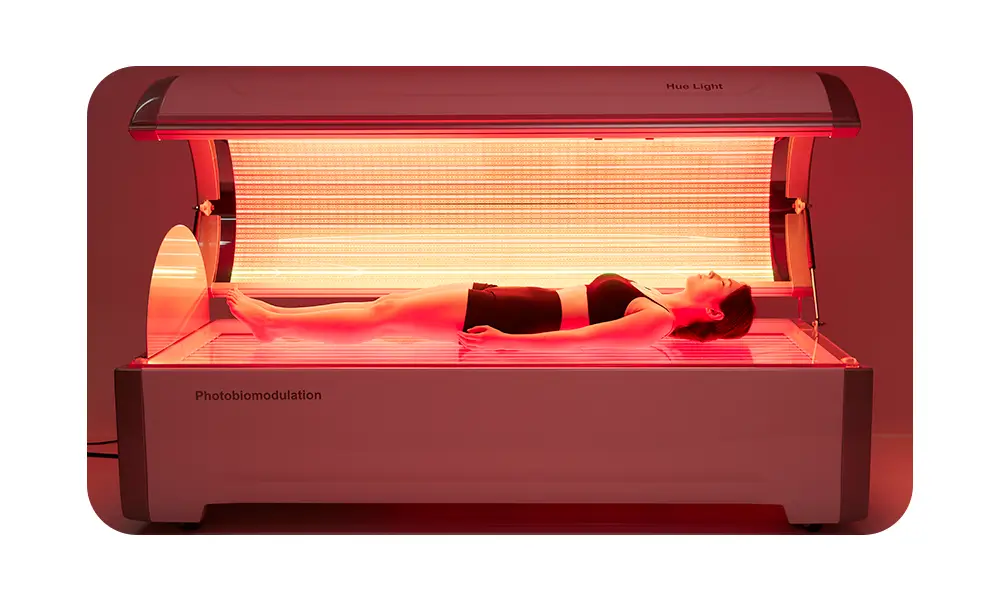
Photobiomodulation (PBM), often referred to as low-level light therapy (LLLT) or red light therapy, is a non-invasive treatment that uses specific wavelengths of red and near-infrared light to stimulate cellular activity and promote healing at the molecular level.
In PBM therapy, light is typically delivered using lasers or light-emitting diodes (LEDs), with wavelengths ranging from 400 nm to 1100 nm. These calibrated wavelengths are chosen for their ability to safely penetrate the skin and reach targeted cells, triggering a range of beneficial biological processes.
At the core of PBM’s mechanism is its effect on mitochondria—the energy powerhouses of cells. PBM enhances mitochondrial function by stimulating cytochrome c oxidase, a key enzyme in the electron transport chain. This stimulation increases the production of adenosine triphosphate (ATP), the molecule that fuels cellular energy. The result? Your body’s tissue repair mechanisms work better, helping to heal faster, reduce pain, and lower inflammation.
The scientific recognition of PBM therapy has grown significantly in recent years. In 2015, the U.S. National Institutes of Health (NIH) formally added Photobiomodulation to its Medical Subject Headings (MeSH) classification system, highlighting its growing acceptance in medical and clinical research.
How does PBM Therapy Work?
“By utilizing light energy within specific wavelength ranges, cells can actually trigger biochemical reactions, significantly increasing ATP production in the mitochondria, which promotes active cell regeneration. During this process, cells produce nitric oxide, enhancing the elasticity of blood vessels, and ROS aids in the treatment of various pathogens.”
– Dr. Harry Whelan, MD, Professor of Neurology at the University of Wisconsin School of Medicine, Neuro-Oncology, American Cancer Society
Detailed Mechanism of PBM Therapy
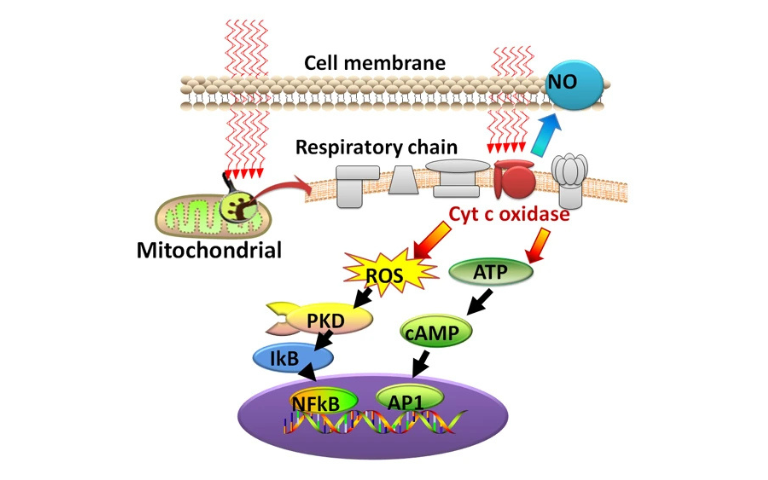
1. Light Absorption by Mitochondria: The therapeutic effect of PBM starts when specific wavelengths of light penetrate the skin and reach the mitochondria; the energy-producing centers of the cell. Here, the light is primarily absorbed by cytochrome c oxidase (CCO), a key enzyme in the mitochondrial respiratory chain. This absorption is crucial, as it triggers the cascade of cellular responses that define PBM’s mechanism of action.
2. Increased ATP Production: Once cytochrome c oxidase absorbs the light energy, mitochondrial activity is enhanced, which increases Adenosine Triphosphate (ATP) production in cells. These elevated ATP levels provide cells with the energy required for vital processes such as tissue repair, protein synthesis, and immune response, thereby accelerating healing and regeneration.
3. Nitric Oxide Release: In conditions of cellular stress or injury, mitochondria can produce excess nitric oxide (NO), which competes with oxygen by binding to cytochrome c oxidase. This inhibits ATP production and increases oxidative stress. PBM light therapy helps by dissociating NO from cytochrome c oxidase, allowing oxygen to bind effectively once again. As a result, mitochondrial function improves, oxidative stress is reduced, and overall cellular efficiency is restored.
4. Reduces Oxidative Stress and Inflammation: PBM induces a controlled increase in reactive oxygen species (ROS). Contrary to harmful oxidative stress, this temporary ROS spike acts as a cell signaling mechanism, stimulating the production of antioxidant enzymes that protect the cell from long-term damage. Moreover, PBM modulates the immune response by downregulating pro-inflammatory cytokines like TNF-α and IL-6 while upregulating anti-inflammatory mediators such as IL-10, promoting a balanced healing environment. (Source)
5. Healing at the Cellular Level: The cumulative effects of improved ATP synthesis, restored mitochondrial function, and reduced inflammation create the ideal conditions for cellular regeneration. Cells become more capable of repairing damage, proliferating, and differentiating into specialized tissue types. This leads to accelerated healing, reduced pain, and better overall tissue function.
Rewiring the Cell: How PBM Helps the Body Heal

Photobiomodulation therapy doesn’t simply mask symptoms; it works at the root level to restore balance and cellular function. By using specific wavelengths of light, PBM enhances mitochondrial activity, reduces inflammation, restores redox balance, and even rewires cellular communication. These biological effects enable the body’s innate healing systems to work more efficiently and effectively.
Whether it’s recovering from injury, managing chronic conditions, or supporting brain health, PBM offers a safe, non-invasive, and evidence-based approach to long-term healing. Let’s break down how PBM supports systemic recovery, one cellular mechanism at a time:
1. Boosting Mitochondrial Function
Mitochondria, your cells’ powerhouses generate over 90% of your body’s energy (ATP). In chronic diseases and aging, mitochondrial function often declines, leading to fatigue, tissue breakdown, and impaired healing.
PBM revitalizes mitochondria by:
- Enhancing ATP production for faster energy delivery.
- Supporting mitochondrial repair and biogenesis.
- Reversing mitochondrial dysfunction linked to aging.
- Increasing cellular energy for key processes like tissue repair, protein synthesis, and immune defense.
More ATP means more energy for cells to perform essential functions like tissue repair, immune defense, protein synthesis, and cellular regeneration.
Fact: A 2020 study in Aging and Disease found PBM can restore mitochondrial function in aging neurons and reduce signs of neurodegeneration.
For more tips on improving mitochondrial function, read our article “3 Proven Ways To Improve Your Mitochondrial Function“.
2. Reducing Chronic Inflammation
Chronic inflammation is a silent contributor to many conditions, including arthritis, cardiovascular disease, diabetes, and depression. PBM addresses inflammation not just symptomatically, but at its molecular source.
PBM reduces inflammation by:
- Lowering pro-inflammatory markers (e.g., TNF-α, IL-6).
- Promoting anti-inflammatory cytokines.
- Reducing oxidative stress via fewer reactive oxygen species (ROS).
- Improving circulation to flush out cellular debris and toxins.
These anti-inflammatory effects help PBM reduce pain, prevent tissue breakdown, and accelerate healing.
Fact: In a 2022 clinical trial on knee osteoarthritis, patients who received PBM three times a week for eight weeks reported a 50% reduction in pain and inflammation.
3. Rewiring: Enhancing Cellular Communication and Repair
Beyond energy and inflammation, PBM has a deeper effect—it helps “rewire” the body at the genetic and molecular signaling level. This modulation enhances how cells communicate and repair themselves.
PBM facilitates cellular repair by:
- Activating anti-apoptotic and antioxidant gene pathways.
- Stimulating stem cell migration and differentiation.
- Modulating transcription factors like NF-κB and HIF-1α.
- Regulating calcium ion (Ca²⁺) flow for balanced cellular signaling.
- Strengthening intercellular communication across tissues.
These effects help transition cells from dysfunction to regeneration, which is especially crucial in degenerative diseases or stalled healing.
Fact: Research has shown that PBM affects genes involved in critical signaling pathways such as JAK/STAT, which are central to wound healing and immune responses.
4. Restoring Redox Balance
Oxidative stress occurs when there’s an imbalance between reactive oxygen species (ROS) and the body’s antioxidant defenses. If left unchecked, this imbalance damages cells, accelerates aging, and fuels disease.
PBM restores redox balance by:
- Generating mild, beneficial ROS to activate healing pathways.
- Stimulating natural antioxidant enzymes such as superoxide dismutase (SOD) and glutathione.
- Preventing oxidative cellular damage across multiple tissue types.
Fact: A 2017 review in Free Radical Biology & Medicine reported that PBM can reduce oxidative stress in both animal and human cells under disease conditions.
PBM in Disease Treatment & Prevention
Photobiomodulation (PBM) therapy is gaining recognition as a groundbreaking, non-invasive approach for treating and preventing a wide variety of health conditions. Its potential spans across chronic illnesses, neurological disorders, pain management, and immune system support.
“I have treated many patients with modern medicine for over 30 years, but to be honest, my medical skills did not advance, nor did they significantly impact my patients’ health. However, phototherapy was exceptional in many ways. It can be said to be a future treatment that addresses the root causes of diseases without side effects.”
– Dr. Len Saputo, MD, John Muir Medical Center in the San Francisco Bay Area, Clinical research on LLLT (Low-Level Light Therapy)
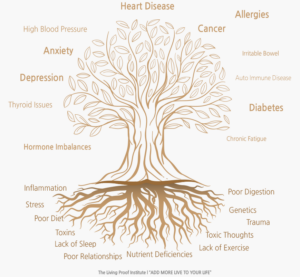
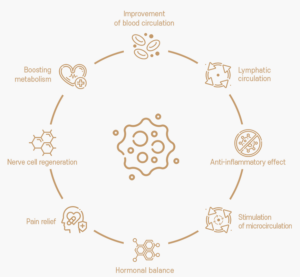
Chronic Pain and Inflammation
PBM therapy is frequently used to manage chronic pain conditions such as arthritis, joint pain, back pain, and neuropathic pain. It works by reducing inflammation, enhancing circulation, and promoting cellular repair, resulting in faster healing and long-term relief. (Study)
Neurological Disorders
Emerging research indicates PBM’s potential in supporting neurological function, particularly in conditions like Alzheimer’s disease, Parkinson’s disease, and traumatic brain injury (TBI). PBM enhances mitochondrial activity in brain cells, improves cerebral blood flow, and modulates inflammation, factors that may contribute to better cognitive function and neuroprotection. (Study)
Immune Support and Faster Recovery
PBM also plays a significant role in immune modulation and recovery. By stimulating cellular energy (ATP) production and accelerating tissue repair, PBM helps the body recover more quickly from surgeries, infections, and physical injuries. Many individuals use PBM routinely to maintain wellness and strengthen their cellular defenses.
Clinical Evidence & Research
Photobiomodulation (PBM) isn’t just another wellness trend. It’s a scientifically validated therapy with decades of peer-reviewed research supporting its effectiveness. From pain relief to cognitive enhancement, PBM is transforming the way we approach healing.
Foundational Research & Historical Milestones
The clinical journey of PBM began in 1971 when Professor Endre Mester published his pioneering paper showing that laser light could accelerate wound healing. By 1984, he had successfully treated over 1,300 patients with chronic wounds and ulcers that hadn’t responded to conventional treatments, marking a major breakthrough in the medical use of red light therapy.
Peer-Reviewed Studies: Evidence Across Health Domains
Numerous studies have confirmed PBM’s therapeutic benefits across multiple conditions. Let’s explore some of the key areas where PBM has shown significant clinical outcomes.
1. Pain Relief & Inflammation
A meta-analysis published in The Lancet (2009) evaluated 16 randomized controlled trials and concluded that PBM significantly reduces pain in patients with chronic joint disorders such as osteoarthritis and rheumatoid arthritis.
“PBM showed a 70% reduction in pain immediately after treatment, with sustained relief over time.” — Bjordal et al., The Lancet, 2009
2. Cognitive Function & Brain Health
A 2017 study in Neuropsychiatric Disease and Treatment found that transcranial PBM improved memory, attention, and executive function in older adults with mild cognitive impairment (MCI).
“Subjects demonstrated significant improvements in executive function and delayed memory recall after 12 weeks of PBM therapy.”— Chao, Wang et al., 2017
3. Wound Healing & Recovery
Research in the Journal of Diabetes Research showed PBM improves diabetic foot ulcer healing.
“PBM enhanced healing in all studies reviewed, but only one adjusted for skin color—highlighting a gap in inclusive research.” — Dhlamini & Houreld, 2022
4. Fibromyalgia & Chronic Fatigue
A randomized controlled trial in Pain Research and Management (2019) reported that full-body PBM significantly reduced pain intensity and improved quality of life for patients with fibromyalgia. — de Andrade et al., 2019
Regulatory Support: FDA Approvals & Clinical Guidelines
The FDA has approved multiple PBM devices for specific applications such as pain relief, wound care, and muscle recovery. These endorsements highlight the safety and clinical validity of PBM when used according to guidelines.
Future Directions in PBM Research
Research is expanding into new territories, including cardiovascular health, cancer support, and gut microbiome modulation. The field owes much to pioneers like Professor Tiina I. Karu, whose work has advanced our understanding of how specific light wavelengths affect cellular behavior. In 2011, she received the Contribution Award from the North American Association for Laser Therapy (NAALT).
As the science evolves, refinements in light delivery and wavelength targeting promise even more precise and effective therapies.
Practical Applications of PBM
Photobiomodulation has moved beyond clinical settings. Today, it’s integrated into wellness routines at home and in professional practice.
At-Home Devices
Modern PBM devices such as red light panels, helmets, and infrared body pads allow for convenient, consistent use at home. They empower users to experience the benefits of PBM on their own terms.
Clinical Treatments
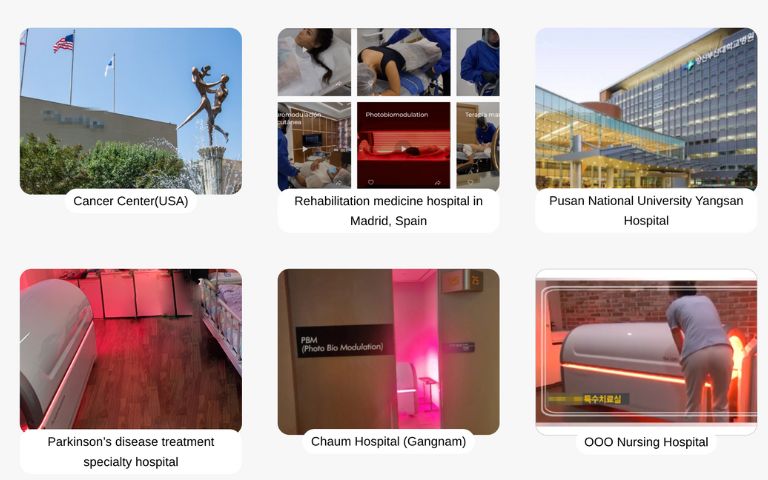
PBM treatments are offered in physiotherapy clinics, wellness centers, dermatology offices, and dental practices. Sessions are typically brief, non-invasive, and require little to no recovery time.
Integrating PBM into a Daily Routine
For optimal results, consistency is key. Most users benefit from 10–20 minute sessions, 3–5 times per week. Focus areas often include joints, the lower back, or the head, depending on your health goals. Always follow your device’s safety instructions.
Final Thoughts: Healing Begins with Light
Photobiomodulation is reshaping modern healthcare. By enhancing cellular energy production, reducing inflammation, and promoting tissue repair, PBM offers a powerful, drug-free approach to wellness.
Whether you’re managing a chronic condition or simply seeking better vitality, PBM delivers results grounded in science.
“Ready to experience it yourself?”
Explore our top-rated PBM device and take your first step toward brighter, healthier living powered by light.
Frequently Asked Questions
What is PBM (Photobiomodulation) Used For?
PBM is used for pain relief, reducing inflammation, improving brain function, speeding recovery, and boosting cellular energy. It’s commonly applied in physical therapy, wound healing, neurological conditions, skin rejuvenation and chronic related diseases.
Is PBM Safe for Daily Use?
Yes, PBM is safe for regular use when used as directed. Most modern PBM devices are non-invasive and designed for consistent, daily application without side effects.
How Soon Can You Expect Results from PBM?
Results can vary depending on the individual and the condition being treated. Some users report noticeable relief after just a few sessions, while others may experience improvements after a few weeks of consistent use.
Can PBM Help Improve Brain Function?
Yes, research indicates that PBM may support brain health, including: improved memory, enhanced focus and better overall cognitive function This is especially promising in managing age-related cognitive decline and neurological conditions.
What kind of light is used in PBM?
PBM therapy relies on red and near-infrared light, typically in the 600–1100 nm wavelength range. These wavelengths are known to penetrate the skin and underlying tissues to stimulate cellular activity and promote healing.













